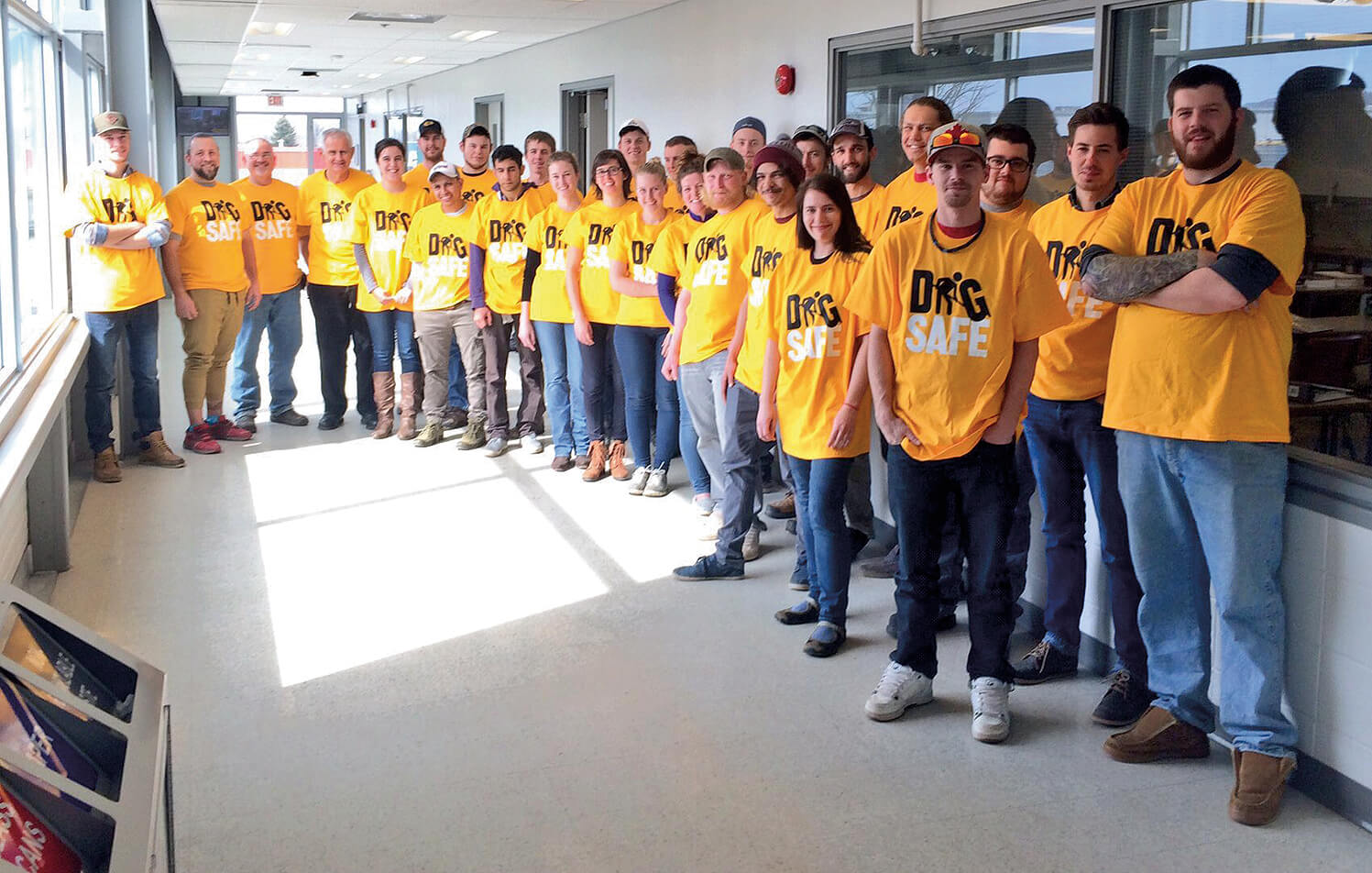April 15, 2016

The annual Dig Safe public awareness campaign included an event at Mohawk College on Mar. 9.
Should landscape contractors do private locates?
By Terry Murphy CLM
 The underground infrastructure in Ontario is a very complicated picture. Bill 8, the Ontario Underground Infrastructure Notification System Act, 2012, was a milestone piece of legislation. This Act basically made a law that all facility owners in the province must be members of the Ontario One Call System and give all their underground data on utilities to ON1CALL. It also means that once a facility owner is notified of a locate request, the markings, or locates as we call them, must then be on the ground within five working days. It is an amazing accomplishment and very significant in the efficiency of the whole process of timely locates. A locate consists of two things: the correct paperwork and markings on the ground. The paperwork must be on the jobsite with the person who is doing the digging.
The underground infrastructure in Ontario is a very complicated picture. Bill 8, the Ontario Underground Infrastructure Notification System Act, 2012, was a milestone piece of legislation. This Act basically made a law that all facility owners in the province must be members of the Ontario One Call System and give all their underground data on utilities to ON1CALL. It also means that once a facility owner is notified of a locate request, the markings, or locates as we call them, must then be on the ground within five working days. It is an amazing accomplishment and very significant in the efficiency of the whole process of timely locates. A locate consists of two things: the correct paperwork and markings on the ground. The paperwork must be on the jobsite with the person who is doing the digging.
At a recent meeting between a landscape contractor and a gas company, the question arose as to whether the landscaper should have their own locate machine and a foreman trained so that he could do his own private locates. That is an excellent question and it may be something the industry should review. One could quickly check the dig location for any possible lines and then call a professional locator to obtain markings from a certified and trained professional if they detect an underground line. Could or should each landscaper be trained to quickly check a dig area to verify there are no utility lines present before he digs? This does not mean the excavating contractors checking would replace a locate request to ON1CALL, but it would be an addition to the free service. If a contractor digs or disturbs the soil, by law he must call ON1CALL for locates. To assist the locate provider, the contractor should spray with white paint where he plans to dig so that the locate provider can double check this area for utilities and provide the appropriate and necessary markings.
The question here is can our industry prevent line strikes by doing a quick check before they dig? Would the contractor see benefit to this process? I know some irrigation contractors have their own locate detection equipment and have the ability to do these quick checks. I believe contractors must ask themselves if this is worthwhile for them to do as well.
Terry Murphy can be reached at tvmurphy@ca.inter.net.
 The underground infrastructure in Ontario is a very complicated picture. Bill 8, the Ontario Underground Infrastructure Notification System Act, 2012, was a milestone piece of legislation. This Act basically made a law that all facility owners in the province must be members of the Ontario One Call System and give all their underground data on utilities to ON1CALL. It also means that once a facility owner is notified of a locate request, the markings, or locates as we call them, must then be on the ground within five working days. It is an amazing accomplishment and very significant in the efficiency of the whole process of timely locates. A locate consists of two things: the correct paperwork and markings on the ground. The paperwork must be on the jobsite with the person who is doing the digging.
The underground infrastructure in Ontario is a very complicated picture. Bill 8, the Ontario Underground Infrastructure Notification System Act, 2012, was a milestone piece of legislation. This Act basically made a law that all facility owners in the province must be members of the Ontario One Call System and give all their underground data on utilities to ON1CALL. It also means that once a facility owner is notified of a locate request, the markings, or locates as we call them, must then be on the ground within five working days. It is an amazing accomplishment and very significant in the efficiency of the whole process of timely locates. A locate consists of two things: the correct paperwork and markings on the ground. The paperwork must be on the jobsite with the person who is doing the digging.Notifications are increasing
Once a locate is requested, a notification is given to all facility owners on that particular street address and each has to then ensure the markings for their utility are completed. The ORCGA Dirt Report indicates that for each locate request in 2014, an average of 6.84 notifications were issued. This is up from 5.73 in 2013 and 4.60 in 2012. The ON1CALL locate markings will be on the ground from the street location into the entrance to the house or building. They do not locate anything beyond the entrance, such as a buried gas or hydro line at the rear of the house, for example, a line that could heat a pool. Any locating of private underground lines in a back or side yard is not marked automatically by your locate request to ON1CALL unless specifically requested. Your locate request can, however, ask that both the backyard and front yard of a property be marked. If it does not, then a contractor will be unaware of any buried lines if they dig in the backyard. The only way to prevent a backyard hit on a utility line is if the property owner or contractor has the backyard checked by a locate provider, private company, or other locate service. Either way, before work begins, there must be a locate request made to ON1CALL. Whoever digs has this responsibility.At a recent meeting between a landscape contractor and a gas company, the question arose as to whether the landscaper should have their own locate machine and a foreman trained so that he could do his own private locates. That is an excellent question and it may be something the industry should review. One could quickly check the dig location for any possible lines and then call a professional locator to obtain markings from a certified and trained professional if they detect an underground line. Could or should each landscaper be trained to quickly check a dig area to verify there are no utility lines present before he digs? This does not mean the excavating contractors checking would replace a locate request to ON1CALL, but it would be an addition to the free service. If a contractor digs or disturbs the soil, by law he must call ON1CALL for locates. To assist the locate provider, the contractor should spray with white paint where he plans to dig so that the locate provider can double check this area for utilities and provide the appropriate and necessary markings.
The question here is can our industry prevent line strikes by doing a quick check before they dig? Would the contractor see benefit to this process? I know some irrigation contractors have their own locate detection equipment and have the ability to do these quick checks. I believe contractors must ask themselves if this is worthwhile for them to do as well.
ORCGA DPT training program
The ORCGA has developed a Damage Prevention Technician (DPT) training program. There are three- and five-day programs. These training programs lead to certification for locators and courses are running throughout the year. A locate provider or a utility themselves would want to have the most qualified technician possible doing their locates. After some on the job experience, technicians take these programs and combine it with their experience to become a Certified Locate Technician. This is an endeavour developed by the ORCGA to insure the industry is getting accurate and correct locates. The DPT programs have been running for over five years and several hundred locators have completed the program. You can contact the ORCGA for more information on programs to develop more expertise for the locate community.Alternate Locate Agreements (ALAs)
Another consideration for the excavating contractor is an Alternate Locate Agreement (ALA) with a utility. What this means is the contractor signs a special agreement with the utility that they will not dig more than 11 inches into the soil. This may be ideal for a landscaper who is planting annuals and perennials in the spring or an irrigation contractor who is installing irrigation piping only six inches deep. If the contractor has such an agreement with a utility, they could get approval over the phone to dig and the actual locate marking may not be necessary. This means the contractor doesn’t have to wait for locates to be completed with markings on the ground. He is given approval over the phone to proceed. This prevents waiting for a locate provider to do locates which may take an extended period of time in March or April when locators are overloaded with requests. The contractor must sign a separate agreement with each utility. I believe the ALA is good for a couple of years and can be renewed with little effort.Conclusion
The entire locate process is an important activity for any landscape or fencing contractor. The purpose of my thoughts in this article is to get people thinking about how we can all work together more effectively with all the partners and deliver our locates in a more efficient manner. Hopefully you will get your locates done in a timely fashion this spring.Terry Murphy can be reached at tvmurphy@ca.inter.net.